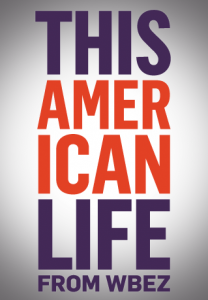On Radio: Ira Glass, Radio Star
 Ira Glass’ iconic voice seems to be everywhere. He guest edited the New York Times Magazine‘s 2011 annual “The Lives They Lived” issue, titled These American Lives – a reference to Glass’ public radio show This American Life (TAL). We heard his voice in 30 Rock‘s 2012 St. Patrick’s day episode, a cameo where he plays himself, attacked by drunken people in his studio while broadcasting TAL. Glass is also on tour, performing a solo spoken word show titled “Reinventing Radio.” On stage, Glass retells stories about the conception and production of This American Life, mixing in pre-taped quotes and music clips from the radio program to demonstrate how he and his crew put the show together and, more importantly, to implicitly argue that TAL has pushed broadcast journalism in a new direction. As the producer and public face of TAL, Glass is positioned as a hip, quirky, radio pioneer. This celebrity star text is constructed through TAL‘s structure and aesthetic as both a radio program and a media franchise, which has been extended to television, film, comic books, and beyond.
Ira Glass’ iconic voice seems to be everywhere. He guest edited the New York Times Magazine‘s 2011 annual “The Lives They Lived” issue, titled These American Lives – a reference to Glass’ public radio show This American Life (TAL). We heard his voice in 30 Rock‘s 2012 St. Patrick’s day episode, a cameo where he plays himself, attacked by drunken people in his studio while broadcasting TAL. Glass is also on tour, performing a solo spoken word show titled “Reinventing Radio.” On stage, Glass retells stories about the conception and production of This American Life, mixing in pre-taped quotes and music clips from the radio program to demonstrate how he and his crew put the show together and, more importantly, to implicitly argue that TAL has pushed broadcast journalism in a new direction. As the producer and public face of TAL, Glass is positioned as a hip, quirky, radio pioneer. This celebrity star text is constructed through TAL‘s structure and aesthetic as both a radio program and a media franchise, which has been extended to television, film, comic books, and beyond.
Glass’ celebrity is further influenced by fan engagement and productions such as Adam WarRock’s “Ira Glass” rap. Throughout all of this, we see Ira Glass very much constructed as a figure who has brought pleasure and entertaining aesthetics to broadcast journalism. Though the paratexts mentioned above arguably create as much meaning about Glass’ star text, his celebrity is always constructed in reference to TAL, and the program’s unique exploitation of the radio feature format. For this reason, we can see how TAL shapes our understanding of Glass’ radio pioneer public persona.
TAL‘s aesthetics make it markedly different from other television and radio journalism. TAL invites listeners to revel in a sort of postmodern opposition to mainstream journalism. The program weaves together informal conversation, first-person monologues, actuality field recordings, sound bites, music, and more into a hip, irreverent weekly radio show. Its self-reflexive style is one aspect that differentiates it from traditional hard news. The show’s commentary and reflection in its own production, usually heard via Glass’ conversation with a producer or participant, works in conjunction with its commentary on traditional journalism to sonically construct the show as self-aware. We see this in the first 10 minutes of Episode 455, “Continental Breakup,” which first aired on January 22, 2012. This episode is about the European debt crisis, and is guest hosted by Alex Blumberg. Here we see TAL taking up a traditional “hard” journalism topic. Yet, the topic is presented in an informal and playful manor. Glass’ nebbish, high, nasally voice begins the program as if in the middle of a private conversation with the listener. He begins quickly by saying, “I think at this point even the most casual news consumer has run across a lot of stories like this….” Next, TAL edits in sound bites from recent news stories and we, the listeners, hear a serious sounding male news reporter saying “The focus of the European debt crisis move today…,” and other successive sound bites related to the economic situation in Europe. This informal, stream of consciousness opening is typical of TAL, as all TAL episodes begin without an introductory frame. This might give listeners the feeling that we enter the show already in the middle of a conversation with Glass and company.
 Next in this episode, Glass does introduce the program, and turns it over to Blumberg. A conversation between Blumberg and Glass ensues, and includes several informal moments that convey naturalness and liveness. Before Blumberg takes over as host, Glass announces, “From WBEZ Chicago, it’s This American Life, distributed by Public Radio International. Alex, I’m just going to hand they show over to you.” This is followed by an unpolished moment of confusion:
Next in this episode, Glass does introduce the program, and turns it over to Blumberg. A conversation between Blumberg and Glass ensues, and includes several informal moments that convey naturalness and liveness. Before Blumberg takes over as host, Glass announces, “From WBEZ Chicago, it’s This American Life, distributed by Public Radio International. Alex, I’m just going to hand they show over to you.” This is followed by an unpolished moment of confusion:
Alex Blumberg: All right and I say, like, “from WBEZ Chicago,” that thing?
Ira Glass: No, I just said that. So you don’t have to say that.
Blumberg: So I don’t have to say that?
Glass: So you can just proceed. Have you heard this show before?
Blumberg: No, you didn’t say “today’s program.”
Glass: All right, I’ll say – you can say “today’s program.”
Blumberg and Glass speak over each other, laughing in a light, friendly way. This unpolished exchange could have easily been edited out in post-production, especially since the trained ear will notice that besides laughter, all signifiers of the body (breathing, et al) have been smoothed out through dialogue editing. This apparently unscripted moment is, however, kept intact, and accomplishes the task of conveying an artificial spontaneous liveness to listeners.
 Overall, Ira Glass is repeatedly constructed in TAL and other media as a charismatic, jovial, informal, self-reflexive, and playful radio journalist. This difference from traditional broadcast journalists who you might find on CNN or even NPR’s All Things Considered has contributed to Glass’ personality as a pioneer of the new age of radio journalism. This is further shaped by TAL’s experimental distribution via events like This American Life LIVE!, where the radio program is performed live onstage with dance numbers, animation, other video, and more. The performance is beamed to movie theatres across the country live. First done in 2009, a new This American Life LIVE! is being broadcast around the country on Thursday, May 10th, and I know I for one will be attending it at a local theatre here in Madison, Wisconsin.
Overall, Ira Glass is repeatedly constructed in TAL and other media as a charismatic, jovial, informal, self-reflexive, and playful radio journalist. This difference from traditional broadcast journalists who you might find on CNN or even NPR’s All Things Considered has contributed to Glass’ personality as a pioneer of the new age of radio journalism. This is further shaped by TAL’s experimental distribution via events like This American Life LIVE!, where the radio program is performed live onstage with dance numbers, animation, other video, and more. The performance is beamed to movie theatres across the country live. First done in 2009, a new This American Life LIVE! is being broadcast around the country on Thursday, May 10th, and I know I for one will be attending it at a local theatre here in Madison, Wisconsin.
This blurring between storytelling, journalism, and media formats troubles traditional notions of ethical reporting and conceptions of truth. Glass goes to great lengths to distinguish himself as an untraditional journalist, and despite (or perhaps because of this) he has received countless major broadcasting awards for journalism. The most recent coverage of the kerfuffle and drama surrounding the veracity of an episode aired earlier this year, “Mr. Daisey and the Apple Factory,” and TAL’s subsequent retraction of the episode in the March 16th in the TAL episode “Retraction,” points to mainstream journalism’s inability to reconcile TAL’s postmodern style of journalism. Having heard the original “Mr. Daisey” episode, I question TAL’s retraction, as the program was very clear that it was featuring portions of Mike Daisey’s one-man play “The Agony and the Ecstasy of Steve Jobs,” and even included a disclaimer at the end noting what Glass and his team were able to fact check and what they could not.
However, this controversy is significant, not because it questions or clarifies the “truth” of This American Life’s episode featuring Daisey, but rather it points to the significance of TAL within the American mediascape. Moreover, at the end of the day, it recuperates Glass’ integrity. In “Retraction,” Glass doesn’t just retract TAL’s previous episode, he interrogates the show’s fact checking process and interviews Daisey again, during which he is self-reflexively critical and idealistic about the boundaries of radio features. Thus, in his humility and self-awareness, Ira Glass is ultimately able to retain his persona as an unconventional, pioneering radio journalist.



Nice discussion of Glass & his seemingly unmediated, yet highly mediated persona. I wonder if you’ve heard his guest stint on Savage Lovecast, where his casual use of the word “cock” and discussion of blowjobs produced some fascinating cognitive dissonance with his star identity. He also provided some great context for why TAL caveats segments by saying that a story “acknowledges the existence of sex.”
Thanks Jason! I haven’t heard of Savage Lovecast, and am gonna check it out right now. I heard him say that TAL acknowledges the existence of sex on their Valentine’s Day program and thought it was just Glass being sarcastic. Very good info – cannot wait to hear this other side of Ira Glass.